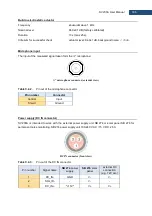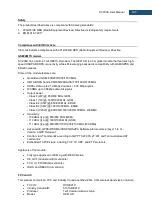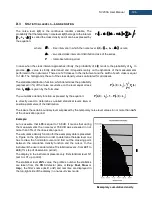
198
SV 200A User Manual
D.3
S
TATISTICAL LEVELS
–
L
NN DEFINITION
The noise level
L(t)
is the continuous random variable. The
probability that the temporary noise level
L(t)
belongs to the interval
L
L
,
L
k
k
+
is called the class density and it can be expressed by
the equation:
( )
P
t
L
L
t
L
L
P
n
1
i
i
k
k
k
=
=
+
where:
i
t
- time intervals, in which the noise level
( )
L
L
,
L
t
L
k
k
+
occurs,
L
- so-called class interval or distribution class of the series,
P
- total observation period.
In case when the class interval approaches infinity, the probability of
L(t)
tends to the probability of
k
L
. In
practice,
L
value is strictly determined and it depends mainly on the dynamics of the measurements
performed in the instrument. There are 120 classes in the instrument and the width of each class is equal
to 1 dB. The histogram is the set of the class density values calculated for all classes.
The statistical distribution function, which determines the probability
(expressed in %) of the noise occurrence on the level equal or less
than
L
L
k
+
is given by the formulae:
( )
( )
=
=
j
1
k
k
j
L
P
L
t
L
P
The cumulative density function, expressed by the equation:
is directly used to determine so-called statistical levels
Lnn
or
position parameters of the distribution.
( )
( )
j
j
L
t
L
P
1
L
t
L
P
−
=
The
Lnn
is the certain boundary level surpassed by the temporary noise level values in not more than
nn%
of the observation period.
Example:
Let us assume that
L35
is equal to 76.8 dB. It means that during
the measurements the noise level 76.8 dB was exceeded in not
more than 35% of the observation period.
The cumulative density function for the exemplary data is presented
in Figure on the right side. In order to determine the
Lnn
level one
has to draw the horizontal cursor and find out the crossing point
between the cumulative density function and the cursor. In the
instrument the user can determine 10 statistical levels - from
L01
to
L99
(1% step of observation period).
The display in the instrument presents only first statistical level N1
(set to: L01 up to L99).
The statistical level
LN%
value, the profile’s number the statistics
are taken from, the RMS detector (
Lin.
, or
Exp.
:
Fast
,
Slow
or
Imp
.), the filter’s name (
A
,
C
or
Z
) and real time are displayed in
the top-right side of the display in one-result view mode.
Exemplary cumulative density
Содержание SV 200A
Страница 123: ...123 SV 200A User Manual Appendix A REMOTE CONTROL firmware revision 1 x x Under development ...
Страница 153: ...153 SV 200A User Manual Free Field Frequency response of SV 200A ...
Страница 164: ...164 SV 200A User Manual 250 Hz 315 Hz 90 deg 0 deg 90 deg 0 deg 400 Hz 500 Hz 90 deg 0 deg 90 deg 0 deg ...
Страница 165: ...165 SV 200A User Manual 630 Hz 800 Hz 90 deg 0 deg 90 deg 0 deg 1000 Hz 1250 Hz 90 deg 0 deg 90 deg 0 deg ...
Страница 166: ...166 SV 200A User Manual 1600 Hz 2000 Hz 90 deg 0 deg 90 deg 0 deg 2240 Hz 2500 Hz 90 deg 0 deg 90 deg 0 deg ...
Страница 167: ...167 SV 200A User Manual 2800 Hz 3150 Hz 90 deg 0 deg 90 deg 0 deg 3550 Hz 4000 Hz 90 deg 0 deg 90 deg 0 deg ...
Страница 168: ...168 SV 200A User Manual 4500 Hz 5000 Hz 90 deg 0 deg 90 deg 0 deg 5600 Hz 6300 Hz 90 deg 0 deg 90 deg 0 deg ...
Страница 169: ...169 SV 200A User Manual 7100 Hz 8000 Hz 90 deg 0 deg 90 deg 0 deg 8500 Hz 9000 Hz 90 deg 0 deg 90 deg 0 deg ...
Страница 170: ...170 SV 200A User Manual 9500 Hz 10000 Hz 90 deg 0 deg 90 deg 0 deg 10600 Hz 11200 Hz 90 deg 0 deg 90 deg 0 deg ...
Страница 177: ...177 SV 200A User Manual 8 0 kHz 1 1 octave filter 4 0 kHz 1 1 octave filter 2 0 kHz 1 1 octave filter ...
Страница 178: ...178 SV 200A User Manual 1 0 kHz 1 1 octave filter 500 Hz 1 1 octave filter 250 Hz 1 1 octave filter ...
Страница 179: ...179 SV 200A User Manual 125 Hz 1 1 octave filter 63 0 Hz 1 1 octave filter 31 5 Hz 1 1 octave filter ...

































